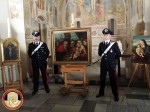 Three 15th century paintings stolen from the Tuscan villa of the Prince of Luxembourg by the Nazis have been found after 72 years. The artworks were first targeted in 1940, under the extension of what had originally been anti-Semitic Italian Racial Laws instituted by Mussolini to kiss Hitler’s ass in 1938. The laws stripped Italian Jews of assets, including art works. In 1940, that law was widened to cover “enemy nationals.” Neutral Luxembourg was occupied by Nazi Germany that same year, and Prince Felix of Bourbon-Parma, husband of Charlotte, Grand Duchess of Luxembourg, and grandfather of the current Grand Duke, was suspected of colluding with the Allies. Under that pretext, the Bourbon-Parma art collection in the Prince’s Villa Borbone delle Pianore in Camaiore, near Lucca in northwest Italy, was confiscated by the Fascist government.
Three 15th century paintings stolen from the Tuscan villa of the Prince of Luxembourg by the Nazis have been found after 72 years. The artworks were first targeted in 1940, under the extension of what had originally been anti-Semitic Italian Racial Laws instituted by Mussolini to kiss Hitler’s ass in 1938. The laws stripped Italian Jews of assets, including art works. In 1940, that law was widened to cover “enemy nationals.” Neutral Luxembourg was occupied by Nazi Germany that same year, and Prince Felix of Bourbon-Parma, husband of Charlotte, Grand Duchess of Luxembourg, and grandfather of the current Grand Duke, was suspected of colluding with the Allies. Under that pretext, the Bourbon-Parma art collection in the Prince’s Villa Borbone delle Pianore in Camaiore, near Lucca in northwest Italy, was confiscated by the Fascist government.
The Prince had other fish to fry at the time. He and his children fled Luxembourg when Germany invaded, traveling through France and Portugal before sailing to the United States. They spent a few months as the guests of General Foods heiress and then-richest women in the United States, Marjorie Merriweather Post, who had become friends with the ruling family when her husband was appointed US Ambassador to Belgium and Envoy to Luxeumbourg in 1938.
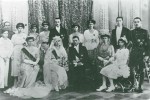 The collection remained in the villa until the spring of 1944 when it was stolen by the 16th SS Panzer Grenadier Division which a few months later would earn even more infamy with massacres of civilians. The SS ultimately planned to transport the loot to Berlin, but first the Bourbon-Parma art and many other works pillaged by the 16th Division were delivered to Dornsberg Castle in the Tyrol, then the residence of Karl Wolff, General of the Waffen-SS and Military Governor of northern Italy. Art looted from all over northern Italy was collected at Dornsberg, and organized and documented with standard Nazi efficiency.
The collection remained in the villa until the spring of 1944 when it was stolen by the 16th SS Panzer Grenadier Division which a few months later would earn even more infamy with massacres of civilians. The SS ultimately planned to transport the loot to Berlin, but first the Bourbon-Parma art and many other works pillaged by the 16th Division were delivered to Dornsberg Castle in the Tyrol, then the residence of Karl Wolff, General of the Waffen-SS and Military Governor of northern Italy. Art looted from all over northern Italy was collected at Dornsberg, and organized and documented with standard Nazi efficiency.
It never got to Germany. In 1945, the Monuments, Fine Arts, and Archives unit of the U.S. 5th Army, better known today as the Monuments Men, under the leadership of Captain Deane Keller recovered the stolen artworks from Dornsberg Castle. Prince Felix read about the liberation of the looted Bourbon-Parma collection in a news article and claimed ownership of the pieces stolen from him. Many of them were still there and the Prince got them back in 1949.
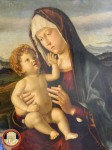 Around 40 of the works stolen from Villa della Pianore were not in Dornberg, among them marble busts of Bourbon rulers of France and paintings by Canaletto, Dosso Dossi, Paris Bordone and Perugino. Prince Felix filed a damages claim and the Italian government reimbursed him for their value, assessed at the then-astronomical sum of $4 million lire, in 1945. The missing works were never forgotten. Seventy years later, the Carabinieri Art Squad of Monza started digging through archives trying to track down these long-lost pieces. After two years of scouring the documentary and photographic archives of the Cini Foundation in Venice, the Zeri in Bologna, the Siviero and Capitoline Archives in Rome, museum center of Florence and the art library of the Castello Sforzesco in Milan, the Carabinieri discovered one of the lost pieces, a Madonna and Child by Gianni Battista Cima
Around 40 of the works stolen from Villa della Pianore were not in Dornberg, among them marble busts of Bourbon rulers of France and paintings by Canaletto, Dosso Dossi, Paris Bordone and Perugino. Prince Felix filed a damages claim and the Italian government reimbursed him for their value, assessed at the then-astronomical sum of $4 million lire, in 1945. The missing works were never forgotten. Seventy years later, the Carabinieri Art Squad of Monza started digging through archives trying to track down these long-lost pieces. After two years of scouring the documentary and photographic archives of the Cini Foundation in Venice, the Zeri in Bologna, the Siviero and Capitoline Archives in Rome, museum center of Florence and the art library of the Castello Sforzesco in Milan, the Carabinieri discovered one of the lost pieces, a Madonna and Child by Gianni Battista Cima 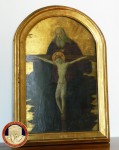 (1460-1518), hanging on the wall of a home in Monza in December of 2014. The family said they had inherited it from a relative who was an art dealer and had no idea of its dirty past. Another of the missing paintings, Holy Trinity by Alessio Baldovinetti (1425-1499), was found in the same home. The third work, Circumcision/Jesus Presented at the Temple by Girolamo dai Libri (1474-1555), was discovered in the home of another family who had inherited it from a collector who died in 1945.
(1460-1518), hanging on the wall of a home in Monza in December of 2014. The family said they had inherited it from a relative who was an art dealer and had no idea of its dirty past. Another of the missing paintings, Holy Trinity by Alessio Baldovinetti (1425-1499), was found in the same home. The third work, Circumcision/Jesus Presented at the Temple by Girolamo dai Libri (1474-1555), was discovered in the home of another family who had inherited it from a collector who died in 1945.
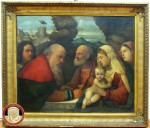 The two families have been charged with receiving stolen goods, but the charges aren’t likely to stick. Meanwhile, the three paintings are at the Pinacoteca di Brera where conservators will give them some much needed love. The works are not in great condition, faded and damaged from their altogether too exciting adventures. The government has yet to decide where the paintings will reside permanently.
The two families have been charged with receiving stolen goods, but the charges aren’t likely to stick. Meanwhile, the three paintings are at the Pinacoteca di Brera where conservators will give them some much needed love. The works are not in great condition, faded and damaged from their altogether too exciting adventures. The government has yet to decide where the paintings will reside permanently.
Luxembourg Freeport, an area with relaxed jurisdiction of customs or related national regulations, is a €50-million high security storage facility adjacent to Luxembourg Findel Airport. The freeport opened in September 2014.
Luxembourg Freeport provides temperature and humidity controlled storage for works of art and other valuables 😎 Don’t you ask silly questions !
I strongly recommend the 2014 book “The Pope and Mussolini.” Pius XI helped bring Mussolini to power, and encouraged actions against the Jews. Overall, it was a shocking story.
It is interesting that the three paintings stolen from the Tuscan villa of the Prince of Luxembourg were all 15th century. Did the Princely family only collect art from the Renaissance? Or was there other, more modern art in the princely collection that was located and repatriated years earlier?
It’s interesting to look at the war memorials in Luxembourg: tanks pointing their guns at Germany, that sort of thing.
Years ago we were in a shop in Luxembourg: the locals were nattering away in their dialect of German. In walked some Germans: the locals swapped immediately to their dialect of French.
By contrast, decades ago my wife (as she then wasn’t) and a friend walked into a pub on Skye, where the locals were nattering in Gaelic. They immediately swapped to English, as a courtesy. Whether the courtesy was routinely extended to people who were not attractive young women I do not know. Quite possibly.
That is an interesting story(ies). When we are in Paris, I –who am a descendant in my mother’s descent almost totally of early US (1620’s) Hollander settlers, and latterly a good deal of French and Scots blood am taken for a Hollander .. as makes sense. My husband –who has a typical American German-Jewish face — looks to Europeans as Italian. (No side curls, no phylacteries etc). Italian people rush up to him on the street and if he hears a street name he knows (and he knows Paris better than NYC where he made his office before 911) he will say, “Ah, Tronchet? Hmm? [and gesturing in a direction] Là bas.” And off, they run.
For shocking stories one need only look to the Revolution in Russia or the Musée Nissam Camando in Paris. For depatriated art I recall that before her fairly recent death Claude Seligmann Deslibes and her sister-in-law were able to receive back one (!) piece from the collection of her father, a noted Parisian art dealer whose stock had been confiscated by the Nazi invaders. Claude spent the years of WWII at a girls’ school in the Bernardsville mountains of NJ. I wish I had traveled more by that time and new more of Paris, as I do now, when I was lucky enough to meet her at “homecoming” some years ago. The outcome of war and especially Revolution is so often only for or with the result of the transfer of wealth and power, with the collateral damage of the cultural history of a country. I wonder who wanted the home of Baron Moise de Camando, in the family since 1860+/-, where the gardens extend those of the Parc Monceau, although restored partly through the help of Mme Jane Engelhard(Bernardsville NJ). (For other transfers in Russia,see “Former People,” Douglas Smith, 2012, Farrar, Strauss.)
For any of you who has not read “The Hare with Amber Eyes” by Edmund de Waal, I highly recommend it. I found it a wonderful, if tragic, story having to do with similar issues. It was so beautifully written that I found myself reading again passages that just were so wonderfully expressed.